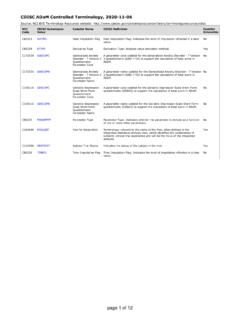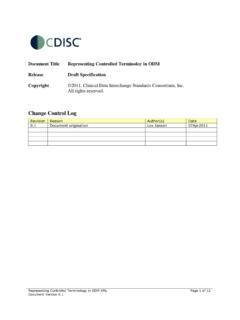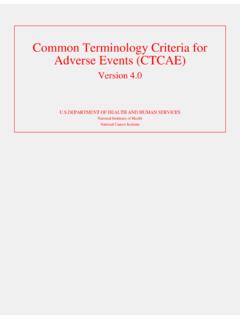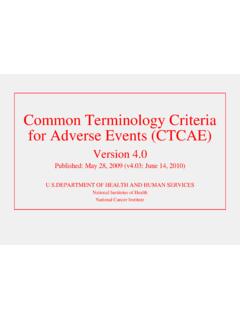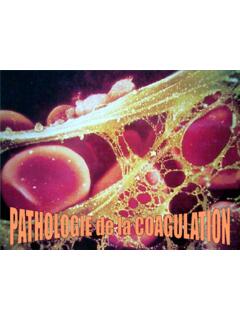Transcription of Common Terminology Criteria for Adverse Events (CTCAE)
1 1. CTCAE Common Terminology Criteria forAdverse Events (CTCAE)Version : May 28, 2009 ( : June 14, 2010) OF HEALTH AND HUMAN SERVICESN ational Institutes of HealthNational Cancer Institute_____ CTCAE incorporates certain elements of the MedDRA Terminology . For further details on MedDRA refer to the MedDRA MSSO Web site ( ). Common Terminology Criteria for Adverse Events (CTCAE) Publish Date: May 28, 2009 Quick Reference The NCI Common Terminology Criteria for Adverse Events is a descriptive Terminology which can be utilized for Adverse Event (AE) reporting. A grading (severity) scale is provided for each AE term. Components and Organization SOC System Organ Class, the highest level of the MedDRA hierarchy, is identified by anatomical or physiological system, etiology, or purpose ( , SOC Investigations for laboratory test results).
2 CTCAE terms are grouped by MedDRA Primary SOCs. Within each SOC, AEs are listed and accompanied by descriptions of severity (Grade). CTCAE Terms An Adverse Event (AE) is any unfavorable and unintended sign (including an abnormal laboratory finding), symptom, or disease temporally associated with the use of a medical treatment or procedure that may or may not be considered related to the medical treatment or procedure. An AE is a term that is a unique representation of a specific event used for medical documentation and scientific analyses. Each CTCAE term is a MedDRA LLT (Lowest Level Term).
3 Definitions A brief definition is provided to clarify the meaning of each AE term. Grades Grade refers to the severity of the AE. The CTCAE displays Grades 1 through 5 with unique clinical descriptions of severity for each AE based on this general guideline: Grade 1 Mild; asymptomatic or mild symptoms; clinical or diagnostic observations only; intervention not indicated. Grade 2 Moderate; minimal, local or noninvasive intervention indicated; limiting age-appropriate instrumental ADL*. Grade 3 Severe or medically significant but not immediately life-threatening; hospitalization or prolongation of hospitalization indicated; disabling; limiting self care ADL**.
4 Grade 4 Life-threatening consequences; urgent intervention indicated. Grade 5 Death related to AE. A Semi-colon indicates or within the description of the grade. A single dash (-) indicates a grade is not available. Not all Grades are appropriate for all AEs. Therefore, some AEs are listed with fewer than five options for Grade selection. Grade 5 Grade 5 (Death) is not appropriate for some AEs and therefore is not an option. Activities of Daily Living (ADL) *Instrumental ADL refer to preparing meals, shopping for groceries or clothes, using the telephone, managing money, etc. **Self care ADL refer to bathing, dressing and undressing, feeding self, using the toilet, taking medications, and not bedridden.
5 CONTENTSSOCPageBlood and lymphatic system disorders3 Cardiac disorders4 Congenital, familial and genetic disorders7 Ear and labyrinth disorders8 Endocrine disorders9 Eye disorders10 Gastrointestinal disorders12 General disorders and administration site conditions22 Hepatobiliary disorders24 Immune system disorders26 Infections and infestations27 Injury, poisoning and procedural complications34 Investigations41 Metabolism and nutrition disorders44 Musculoskeletal and connective tissue disorders46 Neoplasms benign, malignant and unspecified (incl cysts and polyps)50 Nervous system disorders51 Pregnancy, puerperium and perinatal conditions56 Psychiatric disorders57 Renal and urinary disorders59 Reproductive system and breast disorders61 Respiratory, thoracic and mediastinal disorders65 Skin and subcutaneous tissue disorders71 Social circumstances75 Surgical and medical procedures76 Vascular disorders77 CTCAE - June 14, 2010 : Blood and lymphatic system disorders 32.
6 Blood and lymphatic system disordersBlood and lymphatic system disordersGradeAdverse Event12345 AnemiaHemoglobin (Hgb) <LLN - ; <LLN - mmol/L; <LLN -100 g/LHgb < - g/dL; < - ; <100 - 80g/LHgb < g/dL; < mmol/L;<80 g/L; transfusion indicatedLife-threatening consequences;urgent intervention indicatedDeathDefinition: A disorder characterized by an reduction in the amount of hemoglobin in 100 ml of blood. Signs and symptoms of anemia may include pallor of the skin and mucousmembranes, shortness of breath, palpitations of the heart, soft systolic murmurs, lethargy, and marrow hypocellularMildly hypocellular or <=25%reduction from normal cellularityfor ageModerately hypocellular or >25 -<50% reduction from normalcellularity for ageSeverely hypocellular or >50 -<=75% reduction cellularity fromnormal for ageAplastic persistent for longerthan 2 weeksDeathDefinition.
7 A disorder characterized by the inability of the bone marrow to produce hematopoietic intravascularcoagulation -Laboratory findings with nobleedingLaboratory findings andbleedingLife-threatening consequences;urgent intervention indicatedDeathDefinition: A disorder characterized by systemic pathological activation of blood clotting mechanisms which results in clot formation throughout the body. There is an increase in therisk of hemorrhage as the body is depleted of platelets and coagulation neutropenia - -ANC <1000/mm3 with a singletemperature of > degrees C(101 degrees F) or a sustainedtemperature of >=38 degrees C( degrees F) for more thanone consequences;urgent intervention indicatedDeathDefinition: A disorder characterized by an ANC <1000/mm3 and a single temperature of > degrees C (101 degrees F) or a sustained temperature of >=38 degrees C ( F) for more than one evidence ofhemolysis only ( , directantiglobulin test; DAT; Coombs';schistocytes.)
8 Decreasedhaptoglobin)Evidence of hemolysis and >=2gm decrease in or medicalintervention indicated ( ,steroids)Life-threatening consequences;urgent intervention indicatedDeathDefinition: A disorder characterized by laboratory test results that indicate widespread erythrocyte cell membrane uremic syndromeEvidence of RBC destruction(schistocytosis) without clinicalconsequences -Laboratory findings with clinicalconsequences ( , renalinsufficiency, petechiae)Life-threatening consequences,( , CNS hemorrhage orthrombosis/embolism or renalfailure)DeathDefinition: A disorder characterized by a form of thrombotic microangiopathy with renal failure, hemolytic anemia, and severe - ->100,000/mm3 Clinical manifestations ofleucostasis.
9 Urgent interventionindicatedDeathDefinition: A disorder characterized by laboratory test results that indicate an increased number of white blood cells in the node painMild painModerate pain; limitinginstrumental ADLS evere pain; limiting self careADL - -Definition: A disorder characterized by a sensation of marked discomfort in a lymph disorderIncidental findings ( , Howell-Jolly bodies); mild degree ofthrombocytosis andleukocytosisProphylactic antibioticsindicated -Life-threatening consequences;urgent intervention indicatedDeathDefinition: A disorder of the thrombocytopenicpurpuraEvidence of RBC destruction(schistocytosis) without clinicalconsequences -Laboratory findings with clinicalconsequences ( , renalinsufficiency, petechiae)Life-threatening consequences,( , CNS hemorrhage orthrombosis/embolism or renalfailure)DeathDefinition: A disorder characterized by the presence of microangiopathic hemolytic anemia, thrombocytopenic purpura, fever, renal abnormalities and neurological abnormalities suchas seizures, hemiplegia, and visual disturbances.
10 It is an acute or subacute and lymphatic systemdisorders - Other, specifyAsymptomatic or mildsymptoms; clinical or diagnosticobservations only; interventionnot indicatedModerate; minimal, local ornoninvasive interventionindicated; limiting age-appropriate instrumental ADLS evere or medically significantbut not immediately life-threatening; hospitalization orprolongation of existinghospitalization indicated;disabling; limiting self care ADLLife-threatening consequences;urgent intervention indicatedDeathCTCAE - June 14, 2010 : Cardiac disorders 43. Cardiac disordersCardiac disordersGradeAdverse Event12345 Acute coronary syndrome -Symptomatic, progressiveangina; cardiac enzymesnormal; hemodynamically stableSymptomatic, unstable anginaand/or acute myocardialinfarction, cardiac enzymesabnormal, hemodynamicallystableSymptomatic, unstable anginaand/or acute myocardialinfarction, cardiac enzymesabnormal, hemodynamicallyunstableDeathDefinition: A disorder characterized by signs and symptoms related to acute ischemia of the myocardium secondary to coronary artery disease.
